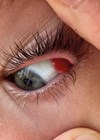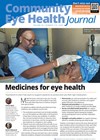Ophthalmology archive for 2023
Work experience in ophthalmology as an A-Level student
Importance of work experience Medical schools expect applicants to understand what a career in medicine involves, which can be gained through work experience and volunteering. It is strongly recommended by the Medical Schools Council that work experience involves working in...
Competition ratios: Is the future of ophthalmology too bright?
In the UK, ophthalmology is a highly competitive speciality, attracting many medical graduates keen to pursue a career in this area. However, in recent years, the competition ratios for ophthalmology ST1 training posts have increased significantly, creating a challenging environment...
Implications of missed foreign bodies under the upper eyelid
Children aren’t the best historians. As a result, clinicians sometimes rely on the accounts of parents regarding problems. Missed foreign bodies due to poor histories or incomplete examinations may result in irreversible loss of vision. This case report shines light...
Uveal melanoma
Uveal melanoma is the most common primary intraocular tumour. However, they are still rare, with an incidence of 2-8 per million [1]. The presence of a choroidal naevus is a risk factor for uveal melanoma [1]. Patients with choroidal lesions...
My top five: Uses of artificial intelligence in ophthalmology
Artificial Intelligence (AI) has emerged as a prominent topic of discussion within the field of ophthalmology, captivating researchers and practitioners alike. Although recent attention has been drawn to the integration of AI in ophthalmology, it’s important to recognise that AI...
The last three patients: dermatology (Patient Three)
For the third and final reflection in this series (see Part 1 and Part 2), Professor Jonathan Rees recounts his experience of a patient with cancer who was failed by the NHS, and how their inadequate treatment illuminates some issues...
Spotlight: The Community Eye Health Journal
In many low-income settings, where vision loss is greatest, eyecare is hampered by shortages in trained health workers. In sub-Saharan Africa, there are fewer than five ophthalmologists per million population, compared to over 70 per million in high-income countries. Eyecare...
Lessons from an unusual case of syphilis
The rise of syphilis transmission rates over the past two decades has been one of public health’s great puzzles. In the UK, the situation has reached epidemic levels, with a 126% increase between 2013 and 2018 [1]. We present a...
Navigating the retina: the nitty-gritty of slit-lamp fundus examination
The slit-lamp fundus examination can be a difficult and disorientating task for beginners due to the retina being viewed in a non-anatomical orientation, the small area of retina illuminated, and the counterintuitive technique of the examination. This article provides a...
How effective is nurse-led telephone preassessment for cataract surgery?
Cataract surgery is the most frequently performed surgical procedure in the UK [1]. The demand for cataract surgery is projected to increase with ageing population, and the recent pandemic has further contributed to the extended waiting times in the UK....
My top five: Elective grants for an ophthalmology elective for a medical student surviving in a cost-of-living crisis
In a time where cost of living is significantly increasing, and the student NHS bursary is remaining stagnant, funding a medical elective is becoming increasingly more challenging for medical students. Surveys have shown that medical students typically get two to...
Retinal sequelae of high voltage electric current injury
Introduction High-voltage electrical currents may result in significant ocular complications, ranging from mild cataracts to vision-threatening retinal and optic nerve problems [1]. The severity of damage depends on various factors, including intensity and type of current, duration of exposure, entry...















